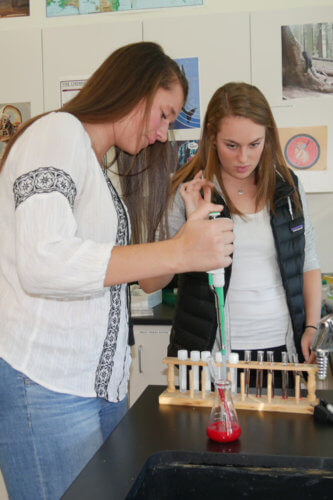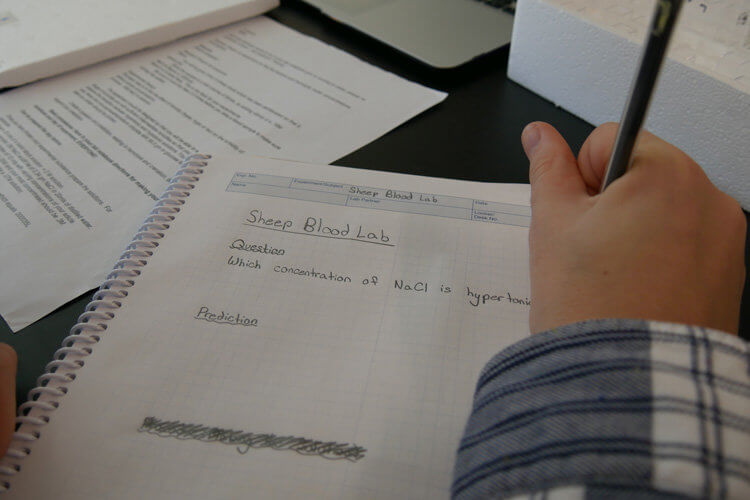Ever since her Freshman year at Colorado Academy, Senior Lena Schneck has wanted to become a physician. Her parents and her extended family are doctors—and she is fascinated by neuroscience, physiology, and learning how the body works. “My parents have taught me that through medicine you can advance science,” Schneck says. “I love the idea that I will be able to serve my community and help people.”
Her CA classmate Mac Behrhorst also wants to study medicine, with a focus on trauma and critical care. When Schneck and Behrhorst signed up for Upper School Honors Physiology, taught by veteran instructor Dani Meyers, both found that they had discovered a path to their passion, a course that offers an introduction to pre-medicine curriculum at the high school level.
“I absolutely love it, because it’s so interactive,” Schneck says. “Rather than just learn philosophy, you learn about real-life experiences.”
“I knew from the first day that I would love it,” Behrhorst adds. “On day one, we dissected a sheep pluck, which includes the heart, lungs, and trachea, to learn about different pulmonary disorders and diseases. Sheep have systems like we do, so this was real!”
That lab on day one provides a foundation for the entire course, which is based on the medical consequence of exposing human beings to extreme conditions. What happens to the circulatory system when a person is deprived of water in the desert? What happens to the digestive system if someone is stranded in the ocean? How does human respiration change in very deep water and at high altitude? How does the immune system respond to jungle diseases? How do humans react to the extreme cold of the Arctic?
Meyers wants students to study physiology in the context of stories. “I taught anatomy out of a textbook to college students for years, and I felt like I was teaching a vocabulary list,” she says. “You remember a story so much better than anything else, so I teach this course through the stories of real people.”

‘Working with their hands’
In place of the typical heavyweight physiology textbook, Meyers’ course focuses on labs, with background reading on human experience: Surviving the Extremes: A Doctor’s Journey to the Limits of Human Endurance, by Kenneth Kamler; Phantoms in the Brain: Probing the Mysteries of the Human Mind, by Sandra Blakeslee and V.S. Ramachandran; and The Man who Mistook his Wife for a Hat, by Oliver Sacks.

Visit the class on any given day, and students will likely be working on a lab. For their study of lung function, they traveled to the top of Berthoud Pass, and at 11,306 feet, they tested their own lung function, checking how long they could hold their breath and also doing cardio activities for three minutes to check the vital capacity of their lungs. Then, they repeated the same activities on the CA campus to compare the data.
During the sheep blood lab, students learned how osmosis affects red blood cells by creating an intravenous solution for a sheep. “We were looking at an isotonic solution with a salt or sugar molecule to create an IV that would be effective in a sheep,” Behrhorst explains. “You learn how IVs are effective in humans.”
In their “fish lab” the students studied how much oxygen fish need to absorb to stay alive and compared their data to human beings. They also tested their own blood to study their blood type and the ratio of red to white blood cells. “Blood was the basis of everything we studied,” Schneck says. “It was really cool to learn about my own blood.”
In the course, students built their own spectrometers, created natural antibiotics, and designed their own experiments.
“I want them to walk away from their computers,” Meyers says. “The goal is to have them working with their hands.”

‘I will remember what I learned for a long time’
The course serves as a cautionary tale for students who might find extreme challenges enticing, particularly in the unit that looks at respiration underwater. Mac Behrhorst explains how, if you surface too quickly, you can experience decompression sickness (“the bends”) even in relatively shallow water. Schneck talks authoritatively about how staying underwater too long can result in nitrogen narcosis, which causes irrational euphoria or anxiety. Both students were impressed by what happens to blood when a person becomes severely dehydrated (“It becomes like sludge, and you are more likely to have a heart attack,” Schneck says.).
“We studied desert, deep water, high altitude—and in every case people either died or miraculously survived,” Behrhorst says. “Either outcome, we learned the drastic effects that nature can have on the human body.”

Meyers gives credit to CA for the hands-on learning opportunities she can provide students. When she asks to order new equipment for lab work, she says the answer is, “Do it!” Her latest purchase is a Bento Lab from England which will allow students to analyze DNA and do genetics research.
“This school is amazing, so the course is constantly evolving and fresh,” she says. “I’m allowed to be a very creative teacher and not stuck to a fixed curriculum.”
Meyers hears back from CA alumni who are now in college and, perhaps no surprise, they tell her that they remember stories from her physiology course. “And then they tell me, ‘What we did at CA in your lab is what we are now doing in college.’”
While Schneck and Behrhorst are looking ahead to a future in science, they emphasize that the course would be interesting for any student. “It is one of the best science classes I have ever taken,” Schneck says. “You learn so much, and I know I will remember what I learned for a long time.”
